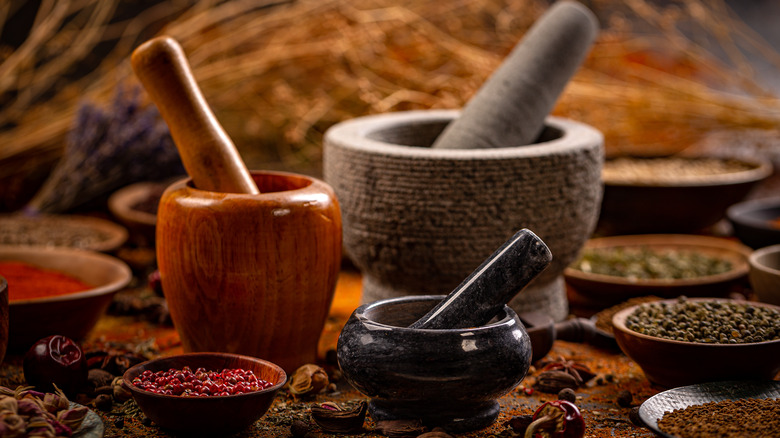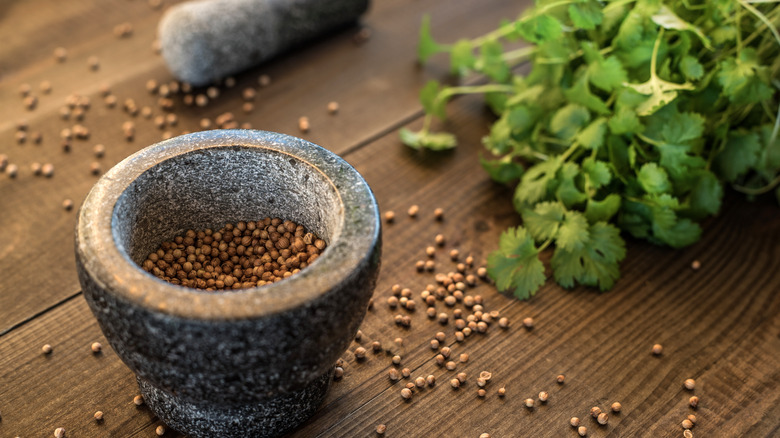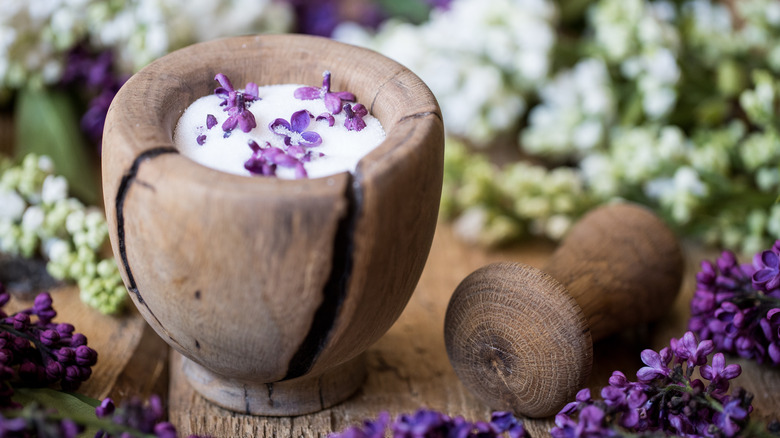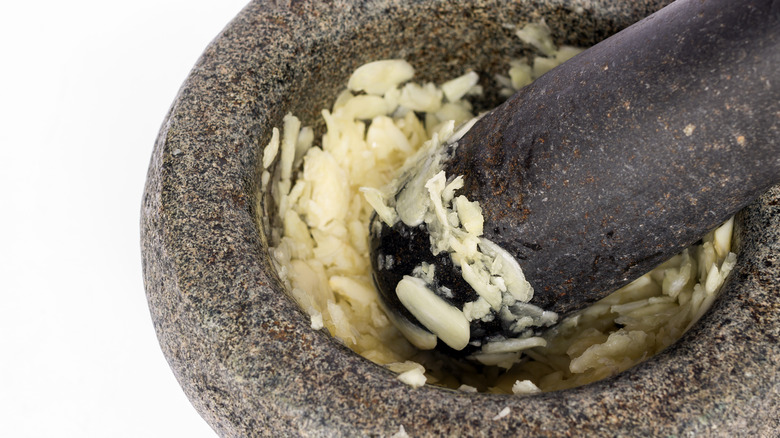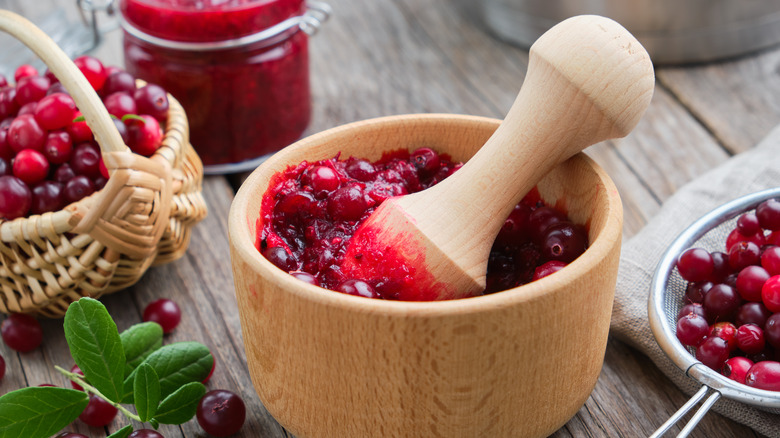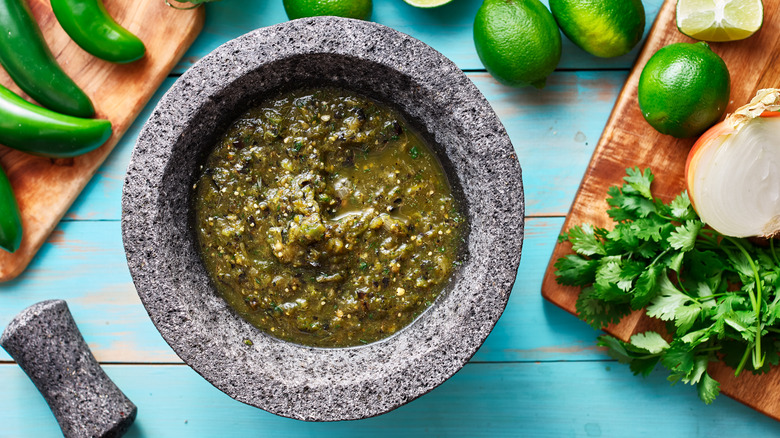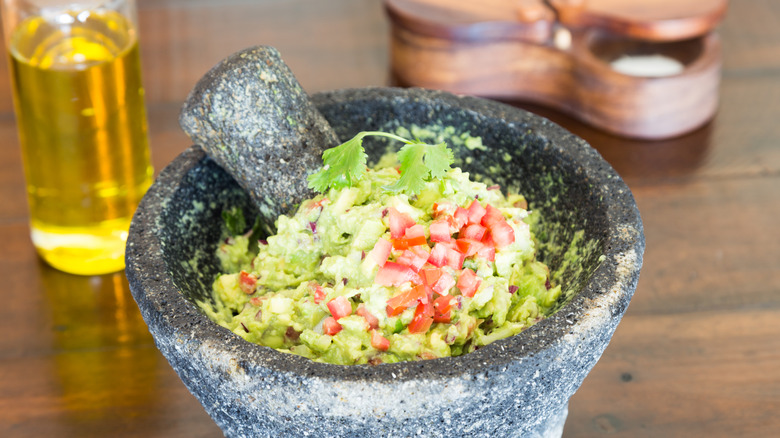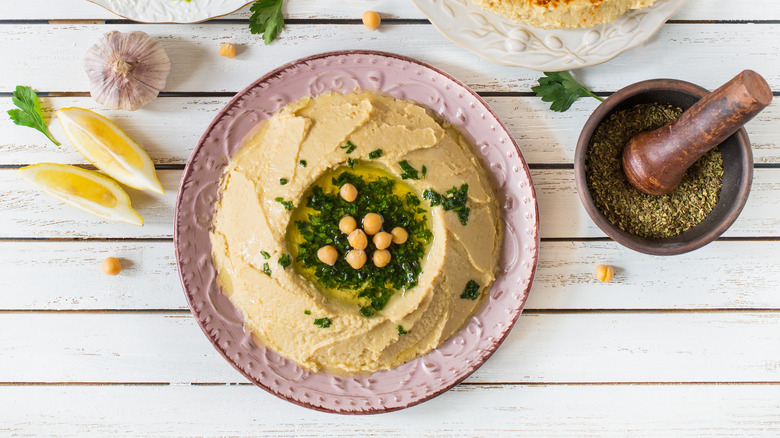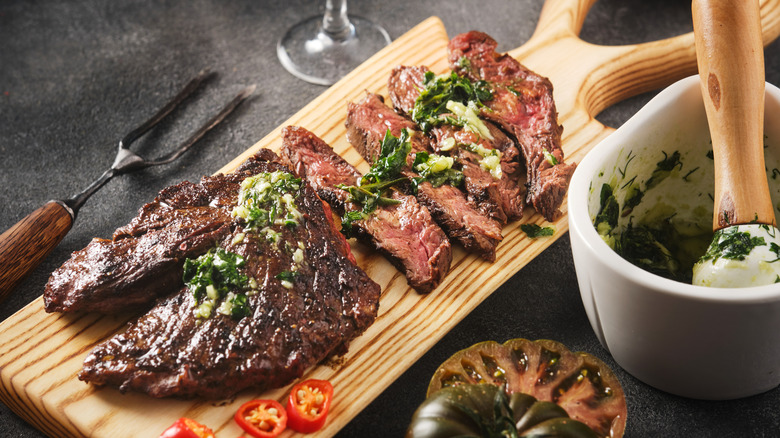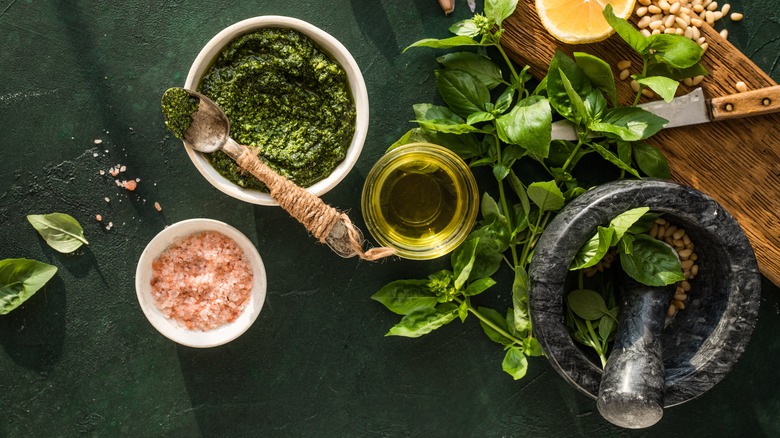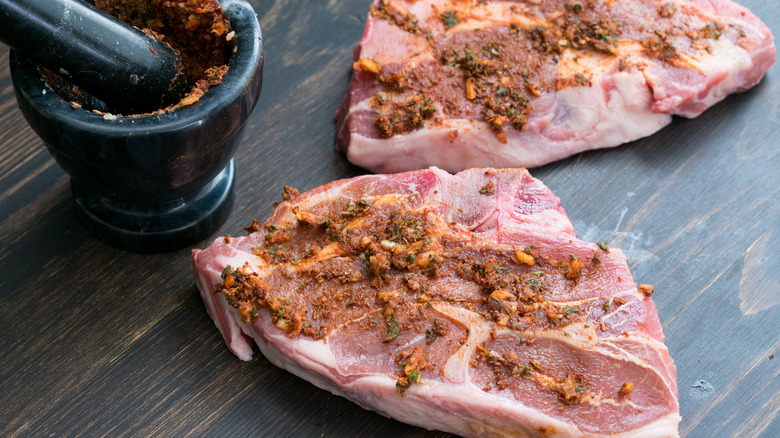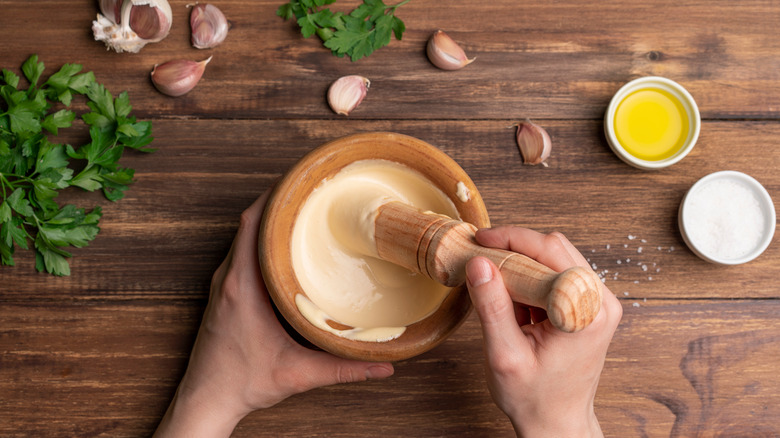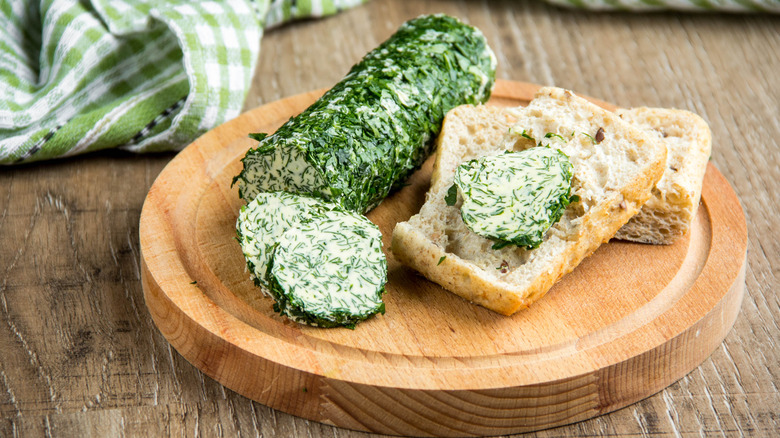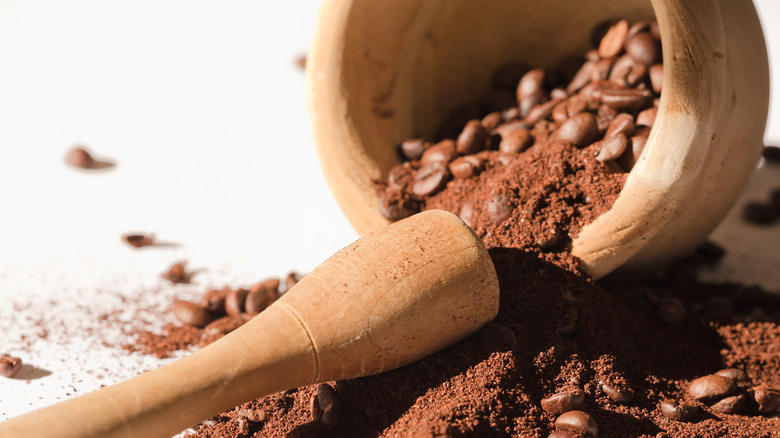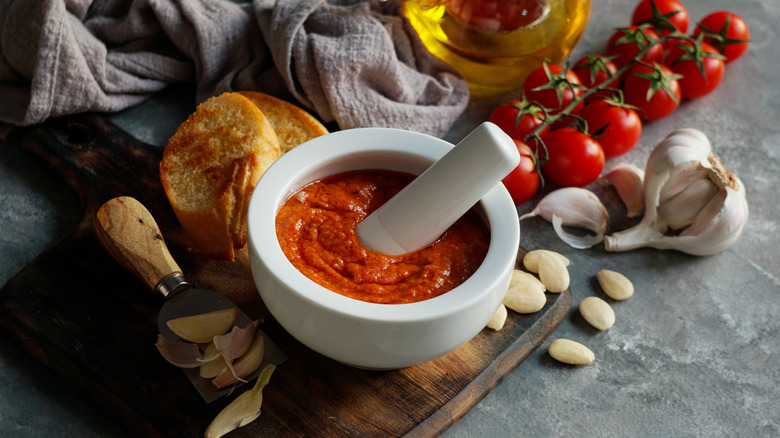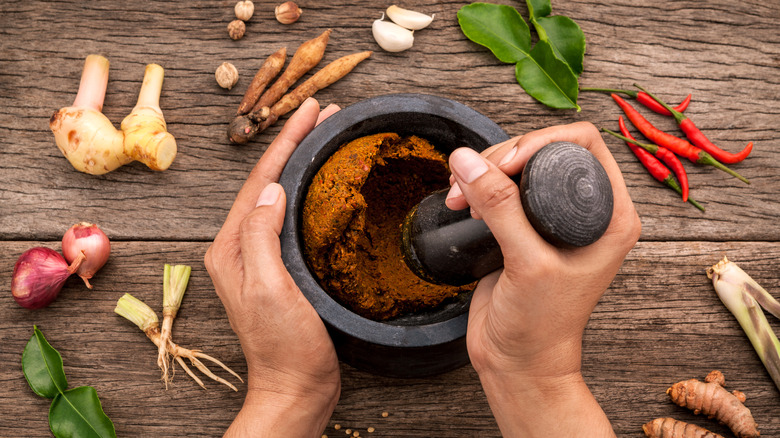15 Best Uses For Your Mortar And Pestle
The mortar and pestle is a classic kitchen tool that's been around for literally thousands of years. A beautiful bowl and its club mate. Two tools that mean nothing on their own, but put them together and you have one of the coolest looking, most useful tools in the kitchen ... if you know how to use it.
This tool, which according to The Atlantic dates all the way back to the Stone Age, comes in multiple shapes and sizes and is constructed from a variety of materials, including wood, glass, classic granite, Middle Eastern brass, and fancy marble. Each material serves its purpose. While a granite mortar and pestle may be best suited for guacamole or hummus, a glass version might be better for dressings and compotes (via The Washington Post). No matter what type of mortar and pestle you own, take advantage of the paring for these cooking uses.
Grind spices by hand
Way back when, the original job of the mortar and pestle was to make medicines and grind up spices, a practice which continues to this day. Using the classic kitchen tool is much easier than opting for the back of a knife or a food processor. Sure, they're both great options, but in the end, all you end up with is the ground up spice. It may not seem like it, but something is missing. By using a mortar and pestle instead, you not only get the spice, but you also get all the aromatics and oils from the spices according to the Farmers Almanac. Those oils and aromatics add even more flavor to whatever recipe for which you're using said spices.
While you can easily grind up a single spice in the mortar and pestle, it's ideal for making spice blends as well. How many times have you seen a recipe that calls for garam masala or Herbs de Provence? Those are just a combination of several spices blended together. Yes, it's true you can buy them premade, but creating them yourself in your own mortar and pestle is much more fun. Not only do you get to choose the spices that go into each blend, but you can also decide on the measurements as well.
Flavor salts and sugars
Similar to spices, grinding up salts and sugars with herbs and zests brings so much more flavor to recipes. While you can find all sorts of flavored salts and sugars online these days, it's so much easier (and cheaper) to make them yourself at home, and there's no better way to do that than with a mortar and pestle. By simply adding fresh herbs to kosher and sea salts, the flavor of the herbs permeates the salts, as do the essential oils. Sprinkling that flavored salt over proteins or into soups and stews gives the finished product a depth you won't get with plain old salt.
The same thing happens with citrus zests or spices and sugars. Sure, plain white sugar is great (and necessary) for that classic cake or cookie recipe. But it can also get stale. Imagine how much more interesting those sugar cookies would be if you used a lemon, lime, or grapefruit sugar or French toast with cinnamon or vanilla bean sugar sprinkled on top. But herbs, spices, and fruits aren't the only thing you can mix with sugars. Dried flowers like lavender and hibiscus add nice floral undertones to cocktails and are beautiful ways to rim glasses when you really want to make a statement.
Crush cloves of garlic
Who out there doesn't love garlic? Next to onions, it's one of the most popular ingredients in the kitchen today per the U.S. Department of Agriculture. While raw cloves of garlic are great stuffed into olives or roasted for soups and stews, nothing beats a nice, thick garlic paste spread over a baguette. A common ingredient in a lot of Italian dishes, garlic is used frequently as the base for a delicious garlic butter that's ideal when spread over sourdough. Crushing the garlic also means it will melt into your sauces and pastas that much easier. The flavor will permeate through the whole sauce, whereas mincing the garlic means you'll end up with uneven chunks.
Not only does crushing garlic make spreading it that much easier, it also helps release all the sulfers that are beneficial to your heart (via Science Daily). But best of all you won't end up with the garlic stench all over you. Yes, garlic is known as the stinking rose for a reason: it really does stink. We don't know about you, but we don't want that smell following us around all day. Using a mortar and pestle to crush the garlic means you won't have that smell lingering on your fingers or hands for hours on end. Instead, that smell and taste will simply linger on your tongue and that's easily taken care of with a nice breath mint.
Transform berries into a compote
Crushing berries is a terrific use of the mortar and pestle, especially since you no longer need to wait for the spring and summer to find fresh and sweet options. These days they can be found year-round at farmers' markets and grocery stores. The fresher the berries are, the more flavor they have and the easier they will be to smash. Crushed berries can be used for compotes which are great ladled over pancakes, waffles and cakes. They're a natural sweetener for smoothies and they also add wonderful flavor and color to refreshing cocktails and mocktails alike.
While berries add a delightful fruity tang that can't be replicated with extracts, the health benefits of a compote are hard to beat. For example, babies will lap them up since they're lower in sugar and easier to swallow. But they're also a great anti-oxidant and help lower cholesterol in adults according to WebMD.
Make a chunkier salsa
Salsa is another great option that benefits from the hand-crushed treatment. In Mexico, you'll likely find a version of a mortar and pestle called a molcajete which is traditionally made from volcanic rock (via MasterClass). That rock helps keep the salsa nice and chunky as opposed to that smooth variety that you might find in jars at the store. Using and grinding up your own ingredients also means that you know what's going into the salsa. You decide which tomatoes to use and if you'd rather go with jalapenos or habaneros for that extra kick.
While you could roughly chop up all those tomatoes, onions, chiles, and cilantro on your favorite cutting board, you may end up losing all those wonderful essential oils from the chilis and vegetables. This is what gives fresh salsa that extra boost of flavor, thereby making it even more vibrant and rich than that awful jarred red stuff that's been sitting on the shelf for who knows how long.
Prepare fresh guacamole
If you've ever been to a fancy Mexican restaurant and ordered guacamole, you've probably gotten a great show. The waiter wheels a cart over to your table full of avocados, chiles, limes, some salsa, and plenty of salt and pepper which is blended together using a giant mortar and pestle, usually made of granite or volcanic stone.
Why? Because with a mortar and pestle of this type, you get a nice, thick chunky guacamole that's perfect for tacos, fajitas, or quesadillas. It's also an ideal appetizer served with a giant basket of homemade tortilla chips. But the best thing about making guacamole in a mortar and pestle is that you are totally in charge of the final product whether you go with a classic version or one with a fruity twist like our fresh mango guacamole recipe. You can watch as the ingredients come together and make decisions as you mix and taste, regulating how much of each ingredient you want to use.
Hummus gets a rustic twist
A classic Middle Eastern appetizer, hummus is another fine option for your mortar and pestle, especially if you like it on the chunkier side. Hummus has been served for centuries and was considered a delicacy among the elites of ancient Egypt (via The National News). The people of Rome, Egypt, and Syria often enjoyed it as both an appetizer and a main course, and that tradition continues today.
Super smooth and creamy, hummus usually gets its consistency from a food processor, which is why it's often served alongside pita bread or naan. But blending it in the mortar and pestle not gives the hummus a more rustic feel and ensures that it will be a great dip for a wide variety of vegetables, breads, and chips. That chunkiness makes it more filling, and causes it to cling to whatever you choose to dip from carrots and cucumbers to pita.
Nail an Argentinian chimichurri
Hailing from Argentina, chimichurri is a staple that can be found everywhere from the corner grocer to Michelin-starred restaurants. Made with fresh parsley, garlic, oil (olive or vegetable), vinegar, and assorted herbs and spice this classic sauce is often drizzled over poultry and meats, particularly steak. While there's nothing wrong with a perfectly seasoned skirt steak that's beautifully seared or grilled to a nice medium-rare. But add a spoonful or two of the stunning green chimichurri, and your beef will reach a whole other level.
Thankfully, chimichurri is a particularly easy sauce to prepare at home, especially when using a mortar and pestle. Similar to salsa, by using a mortar and pestle to grind the parsley and garlic together, you're not simply mixing these ingredients, but rather melding their oils and flavors into one harmonious fusion of a sauce that, according to BBC, has been around since at least the 1800s.
Prepare pesto for your pasta
Pesto is the Italian version of chimichurri. Well, almost. Yes, oil, garlic, and fresh herbs are the base ingredients for both sauces. But where chimichurri uses parsley, the herb of choice for pesto is fresh basil. But the biggest difference between the two is the fact that pesto uses nuts. Now, some people will tell you pesto isn't pesto unless walnuts are used. While there are others who swear the only way to make the thick green sauce is with pine nuts.
But whichever nut you choose, make pesto with a mortar and pestle. It may be easier to use your blender or food processor since it's faster, but the mortar and pestle gets you flavors you simply can't achieve with a knife and a cutting board. Yes, you should still chop up your herbs before you combine them with the other ingredients. But the goal is to chop them without bruising them. If you bruise them on the board, a lot of the flavor will be left there as well and we definitely don't want that. Once the pesto is made, it should be used immediately. But if you prefer to make a large batch and save some for another night, make sure you refrigerate it in an airtight container.
Make marinades and rubs
If there's one way to ensure your meat has character, it's soaking it in a marinade for hours. An easy grilling marinade permeates steak, chicken, or whatever your meat of choice may be with tons of flavor. It can be sweet or savory but whichever way you go, it's going to be so much better because not only will you enhance the taste of your meat, the marinade will tenderize it as well.
While you could whisk up that marinade in a bowl, it's better to make it with a mortar and pestle. Grinding herbs and spices into an oil or vinegar turns that liquid marinade into a thick paste that can then be slathered on your favorite cut of meat and left overnight. Yes, there are plenty of options to buy rubs and marinades out there, but creating your own allows your creativity to flow while choosing exactly which flavors to use. One night could be full of chili and garlic while the next could be rich with sugar and citrus.
Whip up an herbed aioli
Who doesn't love mayonnaise? It's great for sandwiches, dressings, and sauces. There's just one thing — it's kind of plain. One way to remedy that is to jazz yours up with spices, herbs, or garlic. Adding those enhance the flavor and turn your boring old ham and cheese sandwich into something amazing.
The classic aioli is often made with just mayo and garlic, but there are several other options as well. You could add a little citrus to give it a nice tang which would pair well with some seafood, or you could add some fresh herbs to give it a more vegetal flavor. It really just depends on what you're in the mood for that night. While aiolis are often used as dressings and spreads, they also make a great dip. The classic garlic aioli would be perfect as a tartar sauce substitute for some fish & chips. But add a little curry instead, and you have something far better than barbecue sauce for those chicken tenders.
Combine herbs for compound butter
Compound butters are a marvelous option when you want to jazz up that plain old salted butter for everything from a meaty main to basic rolls. Compound butter is simply softened butter that has been mixed together with herbs and spices and then chilled until it's ready for use. While they would definitely make your toast a tad more interesting, compound butters are the perfect way to top a nice, thick, medium-rare steak.
Often found melting over the top of a finished New York Strip, Challenge Butter recommends using compound butters from the first minute you pull out the raw meat to the finished product in order to guarantee the flavor permeates and tenderizes your meat. Most often made with fresh herbs, compound butters can be made with anything from flavored salts to garlic or chiles. You could even add fruits or coffee for something completely different, which would be a delicious alternative for waffles or pancakes.
Grind coffee beans to your specifications
Coffee beans may sound like an odd choice for the mortar and pestle but The Coffee Bean and Tea Leaf highly recommends this kitchen utensil. While a speedy spin in a coffee grinder is usually the first choice for preparing your beans, a mortar and pestle gives you a lot more control over the texture of the beans. You could grind them finely for your coffee or espresso maker or make something a little coarser if you have a French press. You could even use the coffee grounds to give our mocha brownies a little extra umph.
Start by smashing the beans hard in order to crack the outer shell. Then swirl them around the bowl of the mortar until you reach the desired coarseness. Grinding the beans by hand will not only get out any of that pent-up aggression you may be holding on to, but it'll also definitely give your arms a workout as well.
Make the perfect romesco
Similar to pesto, romesco is another sauce that's made with nuts, usually toasted almonds or hazelnuts. But unlike pesto which is made with herbs, romesco's base comes from tomatoes. Roasted tomatoes to be exact. After that, the ingredients change depending on what you have in the pantry and how close you want to get to the classic recipe. Roasting the tomatoes and garlic give the romesco a nice sweet, smokey flavor, while using raw garlic and tomatoes gives it a stronger, pungent zing. But whichever way you choose to go, our romesco sauce recipe is pretty close to the Spanish original. (That's right, romesco hails from Tarragona, a city just south of Barcelona.)
Using a mortar and pestle will help decide how the sauce will be used. It gives you the ability to regulate how mashed up the ingredients will be, thereby determining how thick or thin the final product is. A thicker sauce is perfect for pastas or as a veggie dip, whereas a thinner sauce can be drizzled over a variety of proteins or spread over a nice, crusty piece of bread.
Create a fiery curry paste
Whether you plan on using a green, red, or yellow curry paste for your next dish, why settle for a store-bought jar when you can make your own? We understand that recipes for curry paste can be intimidating due to the long list of ingredients, but it's so worth it. Creating your own paste means you can pick the ingredients, and like other sauces and pastes in this list, you get to make it as thick or thin as you desire.
Our recipe for Thai green curry paste is a great way to get your feet wet. The combination of ginger, galangal, garlic, cumin, coriander, lime leaves, lemongrass, and Thai chile peppers packs a fresh herbaceous punch with just the right amount of heat. Once made, the paste can be incorporated into soups and stir-fries, added to mayonnaise for a tangy aioli, or whisked together with a little oil and vinegar for a zesty salad dressing.
